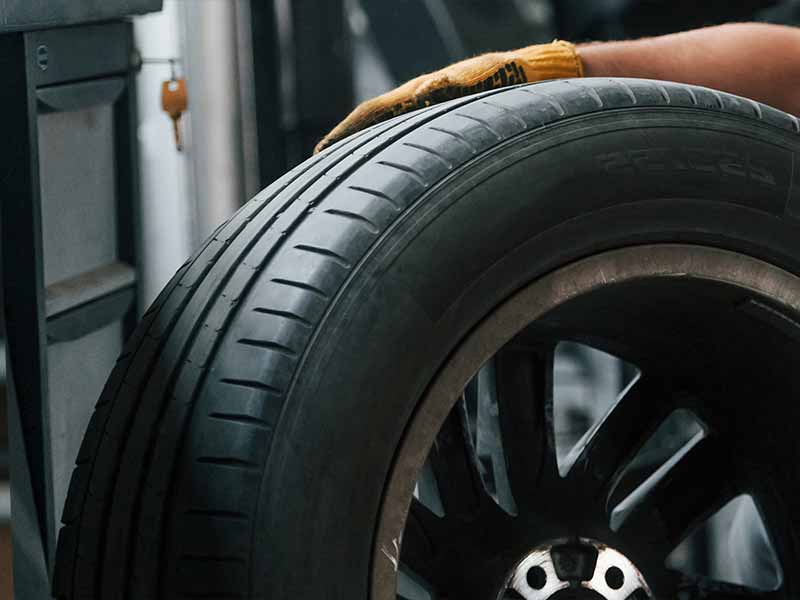Tire size can be surprisingly confusing. Of the 3 main tire size measurements, all of them use a different unit of measure. Aspect ratio is expressed as a percentage. Specifically, a percentage of the tread width, also known as the section width.
What Is The Aspect Ratio Of A Tire?
The tire aspect ratio is the height of the tire sidewall (also known as the profile) compared with the tire width (also known as the tread width). It is represented as a percentage of the tire width.
The tire aspect ratio is listed on the side of all tires and is the second number in the tire size sequence.
You can see an example tire size in the illustration below:
Below is an example showing three different aspect ratios with the same tread width:
These aren’t completely to scale, but make it easier to understand visually what’s going on. It’s important to understand that an aspect ratio of 55 measurement is different depending on the section width. So just because you maintain the aspect ratio between two different size tires doesn’t mean the rolling diameter won’t change.
For instance, the illustration above shows an aspect ratio of 55 and tread width is 245. In other words, 55% of 245mm, or 105.75mm.
As you can see above, all 3 of these tires have the same aspect ratio but they all have different sidewall heights.
Let’s take a closer look.
Tire Aspect Ratio Formula
Since the aspect ratio is listed as a percentage and the tread width is listed in millimeters, you can easily determine the sidewall height in millimeters by multiplying the tread width with the aspect ratio.
Using the previous example, you can determine the aspect ratio in millimeters using the formula below:
245 x .55 = 134.75mm
Tire Aspect Ratio Calculator
Convert Section Width And Aspect Ratio To Sidewall Height In Millimeters
Tire Aspect Ratio Importance
Michelin tire engineer Mark Ludlow is quoted as saying 80 millimeters is the lowest sidewall height that can still perform properly. Without a sufficient amount of sidewall height, the tire will not be able to properly flex in turns and absorb impacts and road imperfections without losing contact with the road surface, damaging the rims, or experiencing more frequent flat tires.
Higher aspect ratio tires will provide a smoother quality ride by absorbing bumps, potholes, and other road imperfections much better and can more easily keep the contact patch of the tires in contact with the road surface.
While lower aspect ratio tires are generally considered to have vehicle handling performance advantages, much taller sidewalls are also capable of performing very well also.
Does The Aspect Ratio Of A Tire Matter?
Aspect ratios are important for maintaining the OEM rolling diameter of your car or truck. Slight changes in rolling diameter shouldn’t cause significant problems aside from a mile or two difference in speedometer reading from actual.
Changing the ratio substantially from the stock measurement without properly changing rim diameter to compensate will cause problems. It will not only cause problems with proper speedometer readings, but will also have negative effects on electronic stability programs and anti-lock braking systems.
While the sidewall to tread width ratio does certainly matter, it’s not as important as some may think.
Modern radial tires are extremely capable of carrying heavy loads and maintain vehicle speed capability with a variety of sidewall profiles.
While many assume that a low profile is required for the best sports car performance, you can look at almost any race car and see that the tire sidewall is actually quite tall when compared to the popular profiles of road-legal vehicles.

What Is The Best Aspect Ratio For Tires?
Since the aspect ratio of a tire is a percentage of the tread width, it’s not possible to say what is the best aspect ratio to use. However, we do know the reasonable minimum sidewall height is 80 millimeters.
You can use the formula previously described to calculate the ratio in millimeters of your tire size and determine whether it is above or below 80 millimeters.
While 80 millimeters is considered the minimum, that doesn’t mean it’s the best. Deciding on the best sidewall height height for your tires will depend on what performance characteristics are most important to you.
Often, the tire’s sidewall height is often chosen based on looks. Low profile tires tend to look better than high profile tires. High profile tires usually ride more smoothly and are less likely to lead to bent rims.
The best tire aspect ratio is the one that balances aesthetics with ride comfort while still maintaining the OEM rolling diameter.
Low Profile Vs High Profile Tires
Generally speaking, low profile tires will have less sidewall flex and better lateral stability. High profile tires will have more flex and worse lateral stability.
Modern radial construction is able to compensate greatly for this though, and higher profiles are able to handle lateral stresses extremely well.
Looking at the much taller sidewall of the tires on any race car will demonstrate that tire manufacturers don’t need to design tires with extremely low profiles to produce a tire capable of handling lateral g-forces well beyond the legal speed limits.

Changing A Tire’s Aspect Ratio (Plus Sizing)
To properly change the sidewall height of your tire, you need to be sure to maintain the OEM rolling diameter. This is done with a method called “Plus Sizing”.
The short description of Plus Sizing is that you reduce the sidewall height by the same amount that in increase the rim diameter. This will maintain the overall rolling diameter of the wheel assembly while reducing the sidewall.
Is It OK To Change Your Aspect Ratio?
It’s okay to change the aspect ratio as long as you maintain the same rolling diameter. If the combined tire and wheel diameter change, systems designed to work with that specific diameter will no longer be able to function properly.
Traction control systems and anti-lock braking will not be able to properly account for wheel spin and slip since the systems will not be receiving the proper information. These systems are designed with a specific tire size designation and they can not automatically sense the change and adjust.
As long as you are compensating for the increase or decrease in sidewall height by increasing or decreasing the wheel diameter to maintain the OEM rolling diameter, there shouldn’t be problems with the electronic control systems.
Depending on how extreme you change the ratio, you may experience side effects. Small changes will likely not be very noticeable. Larger changes will certainly change the driving dynamics.
Shorter sidewalls will give better steering response and lateral grip at the expense of ride quality. Higher profiles will improve ride quality, sometimes dramatically, although they can numb steering feel and reduce lateral grip.
Can I Increase My Tire Aspect Ratio?
The same method used to reduce the tires sidewall height can be used to increase it as well. It is simply the reverse of “Plus Tire Sizing”. Increase the sidewall height while reducing the rim diameter.
Doing this will allow you to maintain the proper wheel diameter while gaining the benefits of a taller sidewall.
Is A Higher Tire Aspect Ratio Better?
Taller sidewalls aren’t necessarily better, but they will usually improve ride quality without causing significant handling and performance problems. However, most people prefer the look of lower profile tires and would consider this a negative.
Low aspect ratio tires are usually praised for their improved steering response and lateral grip. Although the reality is that while this is true, the improvements are rather small in comparison to the reduced ride quality and increased chance of rim damage and sudden tire failure due to sidewall being more prone to flat tires from harsh impacts.
Does The Aspect Ratio Affect The Speedometer?
The aspect ratio can affect the speedometer if it is changed, but only if it changes the overall diameter. Changing the ratio while maintaining the same diameter will have no affect.
Changes in width, such as going from a 205 to 245 width tire size while still having the same ratio will affect the speedometer since they overall diameter will change even though the ratio of tread width to sidewall height remains the same.
How Does A Tire’s Aspect Ratio Affect Ride And Handling?
Generally speaking, taller sidewalls improve ride quality while shorter sidewalls improve lateral grip and steering response.
However, the changes in ride quality can be quite dramatic while the performance improvements are usually more insignificant.
The lower the aspect ratio the more likely you will be to drastically reduce comfort and ride quality while significantly increasing the chances of flat tires and wheel damage.
Resources
Below are some links you may find helpful when learning about tires
- What is tire aspect ratio – Simple Tire
- These sporty, low aspect-ratio tires look great, but that might not help much over a pothole – SFGate
Final Thoughts
Tire aspect ratios are important to understand if you want to change tire sizes. Since aspect ratios are expressed as percentages, they’re unintuitive. You can change the width of a tire but keep the aspect ratio the same and still have a change in sidewall height.
Understanding how to calculate your tire’s sidewall height from the aspect ratio and your tire’s section width can be critical to maintaining the proper rolling diameter and ensuring that safety systems work properly.
If you’re considering getting new tires but plan on changing the tire width or aspect ratio, be sure you completely understand the impact this will have on ride comfort, handling, performance, and stability control systems of your car or truck.




